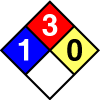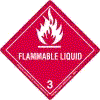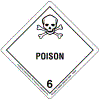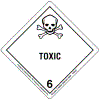Methanol: Systemic Agent
CAS #:
67-56-1
RTECS #: PC1400000
UN #: 1230 (Guide 131)
Common Names:
- Carbinol
- Methyl alcohol
- Wood alcohol
Agent Characteristics
Colorless watery liquid.
Methanol is a toxic alcohol that is used industrially as a solvent, pesticide, and alternative fuel source. It also occurs naturally in humans, animals, and plants. Foods such as fresh fruits and vegetables, fruit juices, fermented beverages, and diet soft drinks containing aspartame are the primary sources of methanol in the human body. Most methanol poisonings occur as a result of drinking beverages contaminated with methanol or from drinking methanol-containing products. In the industrial setting, inhalation of high concentrations of methanol vapor and absorption of methanol through the skin are as effective as the oral route in producing toxic effects. The characteristic pungent (alcohol) odor of methanol does not provide sufficient warning of low levels of exposure.
- Indoor Air: Methanol can be released into indoor air as a liquid spray (aerosol).
- Water: Methanol can be used to contaminate water.
- Food: Methanol may be used to contaminate food.
- Outdoor Air: Methanol can be released into outdoor air as a liquid spray (aerosol).
- Agricultural: If methanol is released into the air as a liquid spray (aerosol), it has the potential to contaminate agricultural products.
Methanol can be absorbed into the body by inhalation, ingestion, skin contact, or eye contact. Ingestion is an important route of exposure.
Personal Protective Equipment
First Responders should use a NIOSH-certified Chemical, Biological, Radiological, Nuclear (CBRN) Self Contained Breathing Apparatus (SCBA) with a Level A protective suit when entering an area with an unknown contaminant or when entering an area where the concentration of the contaminant is unknown. Level A protection should be used until monitoring results confirm the contaminant and the concentration of the contaminant.
NOTE: Safe use of protective clothing and equipment requires specific skills developed through training and experience.
Select when the greatest level of skin, respiratory, and eye protection is required. This is the maximum protection for workers in danger of exposure to unknown chemical hazards or levels above the IDLH or greater than the AEGL-2.
- A NIOSH-certified CBRN full-face-piece SCBA operated in a pressure-demand mode or a pressure-demand supplied air hose respirator with an auxiliary escape bottle.
- A Totally-Encapsulating Chemical Protective (TECP) suit that provides protection against CBRN agents.
- Chemical-resistant gloves (outer).
- Chemical-resistant gloves (inner).
- Chemical-resistant boots with a steel toe and shank.
- Coveralls, long underwear, and a hard hat worn under the TECP suit are optional items.
Select when the highest level of respiratory protection is necessary but a lesser level of skin protection is required. This is the minimum protection for workers in danger of exposure to unknown chemical hazards or levels above the IDLH or greater than AEGL-2. It differs from Level A in that it incorporates a non-encapsulating, splash-protective, chemical-resistant splash suit that provides Level A protection against liquids but is not airtight.
- A NIOSH-certified CBRN full-face-piece SCBA operated in a pressure-demand mode or a pressure-demand supplied air hose respirator with an auxiliary escape bottle.
- A hooded chemical-resistant suit that provides protection against CBRN agents.
- Chemical-resistant gloves (outer).
- Chemical-resistant gloves (inner).
- Chemical-resistant boots with a steel toe and shank.
- Coveralls, long underwear, a hard hat worn under the chemical-resistant suit, and chemical-resistant disposable boot-covers worn over the chemical-resistant suit are optional items.
Select when the contaminant and concentration of the contaminant are known and the respiratory protection criteria factors for using Air Purifying Respirators (APR) or Powered Air Purifying Respirators (PAPR) are met. This level is appropriate when decontaminating patient/victims.
- A NIOSH-certified CBRN tight-fitting APR with a canister-type gas mask or CBRN PAPR for air levels greater than AEGL-2.
- A NIOSH-certified CBRN PAPR with a loose-fitting face-piece, hood, or helmet and a filter or a combination organic vapor, acid gas, and particulate cartridge/filter combination or a continuous flow respirator for air levels greater than AEGL-1.
- A hooded chemical-resistant suit that provides protection against CBRN agents.
- Chemical-resistant gloves (outer).
- Chemical-resistant gloves (inner).
- Chemical-resistant boots with a steel toe and shank.
- Escape mask, face shield, coveralls, long underwear, a hard hat worn under the chemical-resistant suit, and chemical-resistant disposable boot-covers worn over the chemical-resistant suit are optional items.
Select when the contaminant and concentration of the contaminant are known and the concentration is below the appropriate occupational exposure limit or less than AEGL-1 for the stated duration times.
- Limited to coveralls or other work clothes, boots, and gloves.
Emergency Response
- Methanol reacts violently with strong oxidants, causing a fire and explosion hazard.
- Mixtures of methanol vapor and air are explosive.
- Lower explosive (flammable) limit in air (LEL), 6.0%; upper explosive (flammable) limit in air (UEL), 36%.
- Agent presents a vapor explosion and poison (toxic) hazard indoors, outdoors, or in sewers.
- Run-off to sewers may create an explosion hazard.
- Containers may explode when heated.
- Methanol is highly flammable.
- The agent will be easily ignited by heat, sparks, or flames.
- Fire will produce irritating, corrosive, and/or toxic gases.
- Vapors may travel to the source of ignition and flash back.
- Run-off to sewers may create a fire hazard.
- Caution: The agent has a very low flash point. Use of water spray when fighting fires may be inefficient.
- For small fires, use dry chemical, carbon dioxide, water spray, or alcohol-resistant foam.
- For large fires, use water spray, fog, or alcohol-resistant foam. Move containers from the fire area if it is possible to do so without risk to personnel. Dike fire control water for later disposal; do not scatter the agent. Use water spray or fog; do not use straight streams.
- For fire involving tanks or car/trailer loads, fight the fire from maximum distance or use unmanned hose holders or monitor nozzles. Cool containers with flooding quantities of water until well after the fire is out. Withdraw immediately in case of rising sound from venting safety devices or discoloration of tanks. Always stay away from tanks engulfed in fire.
- For massive fire, use unmanned hose holders or monitor nozzles; if this is impossible, withdraw from the area and let the fire burn.
- Run-off from fire control or dilution water may cause pollution.
- If the situation allows, control and properly dispose of run-off (effluent).
- If a tank, rail car, or tank truck is involved in a fire, isolate it for 0.5 mi (800 m) in all directions; also consider initial evacuation for 0.5 mi (800 m) in all directions.
- This agent is not included in the DOT ERG 2004 Table of Initial Isolation and Protective Action Distances.
- In the DOT ERG 2004 orange-bordered section of the guidebook, there are public safety recommendations to isolate a methanol (Guide 131) spill or leak area immediately for at least 150 ft (50 m) in all directions.
- Methanol vapors may be heavier than air. They will spread along the ground and collect and stay in poorly-ventilated, low-lying, or confined areas (e.g., sewers, basements, and tanks).
- Hazardous concentrations may develop quickly in enclosed, poorly-ventilated, or low-lying areas. Keep out of these areas. Stay upwind.
- Liquid agent is lighter than water.
- Health: 1
- Flammability: 3
- Reactivity: 0
- Special:

- OSHA: 91
- NIOSH: 2000, 3800
- AIR MATRIX
Allen TM, Falconer TM, Cisper ME, Borgerding AJ, Wilkerson CW Jr. [2001]. Real-time analysis of methanol in air and water by membrane introduction mass spectrometry. Anal Chem 73(20):4830-4835.De Paula PP, Santos E, De Freitas FT, De Andrade JB [1999]. Determination of methanol and ethanol by gas chromatography following air sampling onto florisil cartridges and their concentrations at urban sites in the three largest cities in Brazil. Talanta 49(2):245-252.Leibrock E, Slemr J [1997]. Method for measurement of volatile oxygenated hydrocarbons in ambient air. Atmos Environ 31(20):3329-3339.Marley NA, Gaffney JS [1998]. A comparison of flame ionization and ozone chemiluminescence for the determination of atmospheric hydrocarbons. Atmos Environ 32(8):1435-1444.
NIOSH [1994]. NMAM Method 2000 Methanol. In: NIOSH Manual of analytical methods. 4th ed. Cincinnati, OH: U.S. Department of Health and Human Services, Public Health Service, Centers for Disease Control and Prevention, National Institute for Occupational Safety and Health, DHHS (NIOSH) Publication 94-113.
OSHA [1980]. Methyl Alcohol Method 91. Salt Lake City, UT. U.S. Department of Labor, Organic Methods Evaluation Branch, OSHA Salt Lake Technical Center.
Qin T, Xu X, Polak T, Pacakova V, Stulik K, Jech L [1997]. A simple method for the trace determination of methanol, ethanol, acetone, and pentane in human breath and in the ambient air by preconcentration on solid sorbents followed by gas chromatography. Talanta 44(9):1683-1690.
Reichert J, Coerdt W, Ache HJ [1993]. Development of a surface acoustic wave sensor array for the detection of methanol in fuel vapours. Sens Actuators B: Chem 13(1-3):293-296.
Tyras H [1989]. Spectrophotometric determination of methyl alcohol in the atmosphere. Z Gesamte Hyg 35(2):96-97.
- OTHER
No references were identified for this sampling matrix for this agent. - SOIL MATRIX
Poole SK, Poole CF [1999]. Chromatographic models for the sorption of neutral organic compounds by soil from water and air. J Chromatogr A 845(1-2):381-400. - SURFACES
Almuzara C, Cos O, Baeza M, Gabriel D, Valero F [2002]. Methanol determination in Pichia pastoris cultures by flow injection analysis. Biotechnol Lett 24(5):413-417. - WATER
Blanco M, Coello J, Iturriaga H, Maspoch S, Porcel M [1999]. Simultaneous enzymatic spectrophotometric determination of ethanol and methanol by use of artificial neural networks for calibration. Anal Chim Acta 398(1):83-92.Martinezsegura G, Rivera MI, Garcia LA [1985]. Methanol analysis by gas-chromatography–comparative-study using 3 different columns. J Agric Univ Puerto Rico 69(2):135-144.Pettersson J, Roeraade J [2003]. Quantitative accuracy in the gas chromatographic analysis of solvent mixtures. J Chromatogr A 985(1-2):21-27.Wilson LA, Ding JH, Woods AE [1991]. Gas-chromatographic determination and pattern-recognition analysis of methanol and fusel oil concentrations in whiskeys. J
Assoc Off Anal Chem 74(2):248-256.
Signs/Symptoms
Adverse health effects from methanol poisoning may not become apparent until after an asymptomatic period of 1 to 72 hours.
Methanol’s toxicity is due to its metabolic products. The by-products of methanol metabolism cause an accumulation of acid in the blood (metabolic acidosis), blindness, and death. Initial adverse health effects due to methanol poisoning include drowsiness, a reduced level of consciousness (CNS depression), confusion, headache, dizziness, and the inability to coordinate muscle movement (ataxia). Other adverse health effects may include nausea, vomiting (emesis), and heart and respiratory (cardiopulmonary) failure. Prognosis is poor in patient/victims with coma or seizure and severe metabolic acidosis (pH <7). Early on after methanol exposure, there may be a relative absence of adverse health effects. This does not imply insignificant toxicity. Methanol toxicity worsens as the degree of metabolic acidosis increases, and thus, becomes more severe as the time between exposure and treatment increases.
- Irritation, redness, and pain.
- Ingestion of methanol may cause a wide range of adverse health effects:
- Neurological: headache, dizziness, agitation, acute mania, amnesia, decreased level of consciousness including coma, and seizure.
- Gastrointestinal: Nausea, vomiting, lack of an appetite (anorexia), severe abdominal pain, gastrointestinal bleeding (hemorrhage), diarrhea, liver function abnormalities, and inflammation of the pancreas (pancreatitis).
- Ophthalmologic: visual disturbances, blurred vision, sensitivity to light (photophobia), visual hallucinations (misty vision, skin over the eyes, snowstorm, dancing spots, flashes), partial to total loss of vision, and rarely eye pain. Visual examination may reveal abnormal findings. Fixed dilated pupils are a sign of severe exposure to methanol.
- Other: Electrolyte imbalances. Kidney failure, blood in the urine (hematuria), and muscle death at the cellular level (rhabdomyolysis) have been reported in severe poisonings. Fatal cases often present with fast heart rate (tachycardia) or slow heart rate (bradycardia) and an increased rate of respiration. Low blood pressure (hypotension) and respiratory arrest occur when death is imminent.
- See Ingestion Exposure.
- Irritation.
- See Ingestion Exposure.
Decontamination
The purpose of decontamination is to make an individual and/or their equipment safe by physically removing toxic substances quickly and effectively. Care should be taken during decontamination, because absorbed agent can be released from clothing and skin as a gas. Your Incident Commander will provide you with decontaminants specific for the agent released or the agent believed to have been released.
The following are recommendations to protect the first responders from the release area:
- Position the decontamination corridor upwind and uphill of the hot zone. The warm zone should include two decontamination corridors. One decontamination corridor is used to enter the warm zone and the other for exiting the warm zone into the cold zone. The decontamination zone for exiting should be upwind and uphill from the zone used to enter.
- Decontamination area workers should wear appropriate PPE. See the PPE section of this card for detailed information.
- A solution of detergent and water (which should have a pH value of at least 8 but should not exceed a pH value of 10.5) should be available for use in decontamination procedures. Soft brushes should be available to remove contamination from the PPE. Labeled, durable 6-mil polyethylene bags should be available for disposal of contaminated PPE.
The following methods can be used to decontaminate an individual:
- Decontamination of First Responder:
- Begin washing PPE of the first responder using soap and water solution and a soft brush. Always move in a downward motion (from head to toe). Make sure to get into all areas, especially folds in the clothing. Wash and rinse (using cold or warm water) until the contaminant is thoroughly removed.
- Remove PPE by rolling downward (from head to toe) and avoid pulling PPE off over the head. Remove the SCBA after other PPE has been removed.
- Place all PPE in labeled durable 6-mil polyethylene bags.
- Decontamination of Patient/Victim:
- Remove the patient/victim from the contaminated area and into the decontamination corridor.
- Remove all clothing (at least down to their undergarments) and place the clothing in a labeled durable 6-mil polyethylene bag.
- Thoroughly wash and rinse (using cold or warm water) the contaminated skin of the patient/victim using a soap and water solution. Be careful not to break the patient/victim’s skin during the decontamination process, and cover all open wounds.
- Cover the patient/victim to prevent shock and loss of body heat.
- Move the patient/victim to an area where emergency medical treatment can be provided.
First Aid
Initial treatment is primarily supportive of respiratory and cardiovascular function. The goal of treatment is to either prevent the conversion of methanol to toxic metabolites or to rapidly remove the toxic metabolites and correct metabolic and fluid abnormalities.
Fomepizole and ethanol are effective antidotes against methanol toxicity. Fomepizole or ethanol should be administered as soon as possible once the patient/victim has been admitted to a medical care facility. See Long Term Implications: Medical Treatment for further instruction.
- Immediately remove the patient/victim from the source of exposure.
- Immediately wash eyes with large amounts of tepid water for at least 15 minutes.
- Seek medical attention immediately.
- Immediately remove the patient/victim from the source of exposure.
- Ensure that the patient/victim has an unobstructed airway.
- Do not induce vomiting (emesis).
- Seek medical attention immediately.
- Immediately remove the patient/victim from the source of exposure.
- Evaluate respiratory function and pulse.
- Ensure that the patient/victim has an unobstructed airway.
- If shortness of breath occurs or breathing is difficult (dyspnea), administer oxygen.
- Assist ventilation as required. Always use a barrier or bag-valve-mask device.
- If breathing has ceased (apnea), provide artificial respiration.
- Seek medical attention immediately.
- Immediately remove the patient/victim from the source of exposure.
- See the Decontamination section for patient/victim decontamination procedures.
- Seek medical attention immediately.
Long-Term Implications
Antidotes fomepizole or ethanol should be administered intravenously as soon as possible to block the conversion of methanol to formic acid and prevent acidosis. Fomepizole is preferred as its efficacy and safety have been demonstrated, and its therapeutic dose is more easily maintained. Once the patient/victim has become acidotic, administration of fomepizole or ethanol may not provide much benefit, but they may be administered at the discretion of the physician in charge. Hemodialysis is the most effective form of treatment for an acidotic patient/victim. Folinic acid (leucovorin) should also be administered intravenously to increase the rate at which formate is metabolized into less toxic chemicals.
The most common permanent adverse health effects following severe methanol poisoning are damage to or death of the nerve leading from the eye to the brain (optic neuropathy or atrophy), resulting in blindness; disease caused by damage to a particular region of the brain, resulting in difficulty walking and moving properly (Parkinsonism); damage to the brain caused by exposure to toxins, resulting in abnormal thought (encephalopathy); and damage to the peripheral nervous system.
Methanol is not suspected to be a carcinogen. Chronic or repeated exposure to methanol is suspected to be a developmental toxicity risk. It is unknown whether chronic or repeated exposure to methanol is a reproductive toxicity risk. Methanol may cause birth defects of the central nervous system in humans. Chronic poisoning from repeated exposure to methanol vapor may produce inflammation of the eye (conjunctivitis), recurrent headaches, giddiness, insomnia, stomach disturbances, and visual failure. The most noted health consequences of longer-term exposure to lower levels of methanol are a broad range of effects on the eye. Inflammatory changes and irritation of the skin (dermatitis), occurs with chronic or repeated exposure to methanol.
On-Site Fatalities
- Consult with the Incident Commander regarding the agent dispersed, dissemination method, level of PPE required, location, geographic complications (if any), and the approximate number of remains.
- Coordinate responsibilities and prepare to enter the scene as part of the evaluation team along with the FBI HazMat Technician, local law enforcement evidence technician, and other relevant personnel.
- Begin tracking remains using waterproof tags.
- Wear PPE until all remains are deemed free of contamination.
- Establish a preliminary (holding) morgue.
- Gather evidence, and place it in a clearly labeled impervious container. Hand any evidence over to the FBI.
- Remove and tag personal effects.
- Perform a thorough external evaluation and a preliminary identification check.
- See the Decontamination section for decontamination procedures.
- Decontaminate remains before they are removed from the incident site.
Occupational Exposure Limits
- NIOSH REL:
- STEL (skin): 250 ppm (325 mg/m3)
- TWA (skin): 200 ppm (260 mg/m3)
- OSHA PEL:
- TWA (8-hour): 200 ppm (260 mg/m3)
- ACGIH TLV:
- STEL (skin): 250 ppm
- TLV (skin): 200 ppm
- NIOSH IDLH: 6,000 ppm
- DOE TEEL:
- TEEL-0: 250 mg/m3
- TEEL-1: 694 mg/m3
- TEEL-2: 2,750 mg/m3
- TEEL-3: 9,300 mg/m3
- AIHA ERPG:
- ERPG-1: 200 ppm
- ERPG-2: 1,000 ppm
- ERPG-3: 5,000 ppm
Acute Exposure Guidelines
| 10 min | 30 min | 60 min | 4 hr | 8 hr | |
|---|---|---|---|---|---|
| AEGL 1 (discomfort, non-disabling) – ppm |
670 ppm | 670 ppm | 530 ppm | 340 ppm | 270 ppm |
| AEGL 2 (irreversible or other serious, long-lasting effects or impaired ability to escape) – ppm |
11,000 ppm* | 4,000 ppm | 2,100 ppm | 730 ppm | 520 ppm |
| AEGL 3 (life-threatening effects or death) – ppm |
** | 14,000 ppm* | 7,200 ppm* | 2,400 ppm | 1,600 ppm |
Lower Explosion Limit (LEL) = 55,000 ppm
* = > 10% LEL; ** = > 50% LEL
AEGL 3 – 10 min = ** 40,000 ppm
For values denoted as * safety consideration against the hazard(s) of explosion(s) must be taken into account
For values denoted as ** extreme safey considerations against the hazard(s) of explosion(s) must be taken into account
Level of Distinct Order Awareness (LOA) = 8.9 ppm
IMPORTANT NOTE: Interim AEGLs are established following review and consideration by the National Advisory Committee for AEGLs (NAC/AEGL) of public comments on Proposed AEGLs. Interim AEGLs are available for use by organizations while awaiting NRC/NAS peer review and publication of Final AEGLs. Changes to Interim values and Technical Support Documents may occur prior to publication of Final AEGL values. In some cases, revised Interim values may be posted on this Web site, but the revised Interim Technical Support Document for the chemical may be subject to change. (Further information is available through AEGL Process).
Decontamination (Environment and Equipment)
The following methods can be used to decontaminate the environment/spillage disposal:
- Do not touch or walk through the spilled agent if at all possible. However, if you must, personnel should wear the appropriate PPE during environmental decontamination. See the PPE section of this card for detailed information.
- Keep combustibles (e.g., wood, paper, and oil) away from the spilled agent. Use water spray to reduce vapors or divert vapor cloud drift. Avoid allowing water runoff to contact the spilled agent.
- Do not direct water at the spill or the source of the leak.
- Stop the leak if it is possible to do so without risk to personnel, and turn leaking containers so that gas rather than liquid escapes.
- Prevent entry into waterways, sewers, basements, or confined areas.
- Isolate the area until gas has dispersed.
- Ventilate the area.
Agents can seep into the crevices of equipment making it dangerous to handle. The following methods can be used to decontaminate equipment:
- Not established/determined
Agent Properties
- Chemical Formula:
CH3OH - Aqueous solubility:
Soluble - Boiling Point:
148.5°F (64.7°C) - Density:
Liquid: 0.79 g/cm3 at 68°F/39°F (20°C/4°C)
Vapor: 1.11 (air = 1) - Flammability:
Highly flammable - Flashpoint:
54°F (12°C)
- Ionization potential:
10.84 eV
- Log Kbenzene-water:
Not established/determined - Log Kow (estimated):
-0.77 - Melting Point:
-144°F (-97.8°C) - Molecular Mass:
32.04
- Soluble In:
Miscible with most organic solvents.
- Specific Gravity:
0.79 - Vapor Pressure:
96 mm Hg at 68°F (20°C)
127 mm Hg at 77°F (25°C) - Volatility:
Not established/determined
Hazardous Materials Warning Labels/Placards
- Shipping Name:
Methanol - Identification Number:
1230 (Guide 131) - Hazardous Class or Division:
3 - Subsidiary Hazardous Class or Division:
6.1 - Label:
Flammable Liquid
Poison (Toxic) - Placard Image:
Trade Names and Other Synonyms
- Alcohol, methyl
- Alcool methylique (French)
- Alcool metilico (Italian)
- Bieleski’s solution
- Coat-B1400
- Colonial spirit(s)
- Columbian spirit(s)
- Eureka Products Criosine Disinfectant
- Eureka Products, Criosine
- Freers Elm Arrester
- Ideal Concentrated Wood Preservative
- Metanol (Spanish)
- Metanolo (Italian)
- Methyl hydrate
- Methyl hydroxide
- Methylalkohol (German)
- Methylol
- Metylowy alkohol (Polish)
- Monohydroxymethane
- Pyroligneous spirit
- Pyroxylic spirit(s)
- Surflo-B17
- Wilbur-Ellis Smut-Guard
- Wood naphtha
- Wood spirit
- X-Cide 402 Industrial Bactericide
In the event of a poison emergency, call the poison center immediately at 1-800-222-1222. If the person who is poisoned cannot wake up, has a hard time breathing, or has convulsions, call 911 emergency services.
For information on who to contact in an emergency, see the CDC website at emergency.cdc.gov or call the CDC public response hotline at (888) 246-2675 (English), (888) 246-2857 (Español), or (866) 874-2646 (TTY).
The user should verify compliance of the cards with the relevant STATE or TERRITORY legislation before use. NIOSH, CDC 2003.



